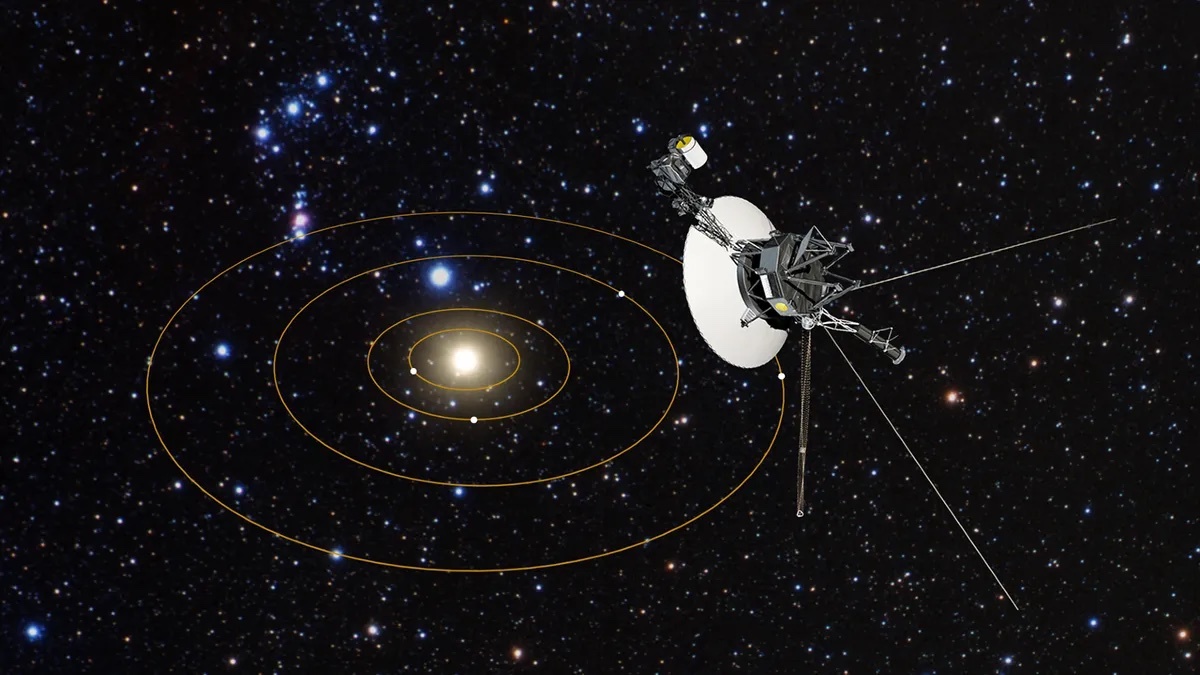13.12.2023
Right now, the only data the probe is sending back to Earth is binary gobbledygook.

Artist's illustration of Voyager 1 probe looking back at the solar system from a great distance. (Image credit: NASA, ESA, and G. Bacon (STScI))
NASA's Voyager 1 probe is currently unable to transmit any scientific or systems data back to Earth. The 46-year-old spacecraft is capable of receiving commands, but a problem seems to have arisen with the probe's computers.
Voyager 1's flight data system (FDS), which collects onboard engineering information and data from the spacecraft's scientific instruments, is no longer communicating as expected with the probe's telecommunications unit (TMU), according to a NASA blog post on Dec. 12.
When functioning properly, the FDS compiles the spacecraft's info into a data package, which is then transmitted back to Earth using the TMU. Lately, that data package has been "stuck," the blog post said, "transmitting a repeating pattern of ones and zeros." Voyager's engineering team traced the problem back to the FDS, but it could be weeks before a solution is found.
Voyager 1, and its twin spacecraft Voyager 2, launched in 1977 and have been operational longer than any other spacecraft in history. Both are in interstellar space, speeding into the cosmos more than 15 billion miles (24 billion kilometers) from Earth.
They are so far away, in fact, that it takes nearly a day (22.5 hours) for a transmission to reach the spacecraft, and another day to receive any sort of response. A single back-and-forth communication with Voyager 1 takes 45 hours. So, whenever NASA engineers are able to send a fix for the probe's FDS, they will have to wait until the following day to find out if it works.
And the solution won't be as simple as just turning the system on and off again (they tried that — it didn't work). The spacecraft's age and hardware present a unique set of challenges. NASA technicians must work within the framework and technology available to their predecessors in the 1970s, sometimes forcing some creative software work-arounds.
This isn't the first malfunction Voyager 1 has experienced in recent years. Issues with the probe's attitude articulation and control system (AACS) were noticed in May 2022, and persisted transmitting nonsense telemetry data for several months before a workaround was found.
Another update came in October 2023, with a software patch to help ultimately solve that issue, and also prevent residue build-up on the probes' thrusters. But these kinds of updates don't come quickly. NASA's blog clarifies, "finding solutions to challenges the probes encounter often entails consulting original, decades-old documents written by engineers who didn’t anticipate the issues that are arising today. As a result, it takes time for the team to understand how a new command will affect the spacecraft’s operations in order to avoid unintended consequences."
Quelle: SC
+++
Engineers Working to Resolve Issue With Voyager 1 Computer
Engineers are working to resolve an issue with one of Voyager 1’s three onboard computers, called the flight data system (FDS). The spacecraft is receiving and executing commands sent from Earth; however, the FDS is not communicating properly with one of the probe’s subsystems, called the telemetry modulation unit (TMU). As a result, no science or engineering data is being sent back to Earth.
Among other things, the FDS is designed to collect data from the science instruments as well as engineering data about the health and status of the spacecraft. It then combines that information into a single data “package” to be sent back to Earth by the TMU. The data is in the form of ones and zeros, or binary code. Varying combinations of the two numbers are the basis of all computer language.
Recently, the TMU began transmitting a repeating pattern of ones and zeros as if it were “stuck.” After ruling out other possibilities, the Voyager team determined that the source of the issue is the FDS. This past weekend the team tried to restart the FDS and return it to the state it was in before the issue began, but the spacecraft still isn’t returning useable data.
It could take several weeks for engineers to develop a new plan to remedy the issue. Launched in 1977, the spacecraft and its twin, Voyager 2, are the two longest-operating spacecraft in history. Finding solutions to challenges the probes encounter often entails consulting original, decades-old documents written by engineers who didn’t anticipate the issues that are arising today. As a result, it takes time for the team to understand how a new command will affect the spacecraft’s operations in order to avoid unintended consequences.
In addition, commands from mission controllers on Earth take 22.5 hours to reach Voyager 1, which is exploring the outer regions of our solar system more than 15 billion miles (24 billion kilometers) from Earth. That means the engineering team has to wait 45 hours to get a response from Voyager 1 and determine whether a command had the intended outcome.
Quelle: NASA
